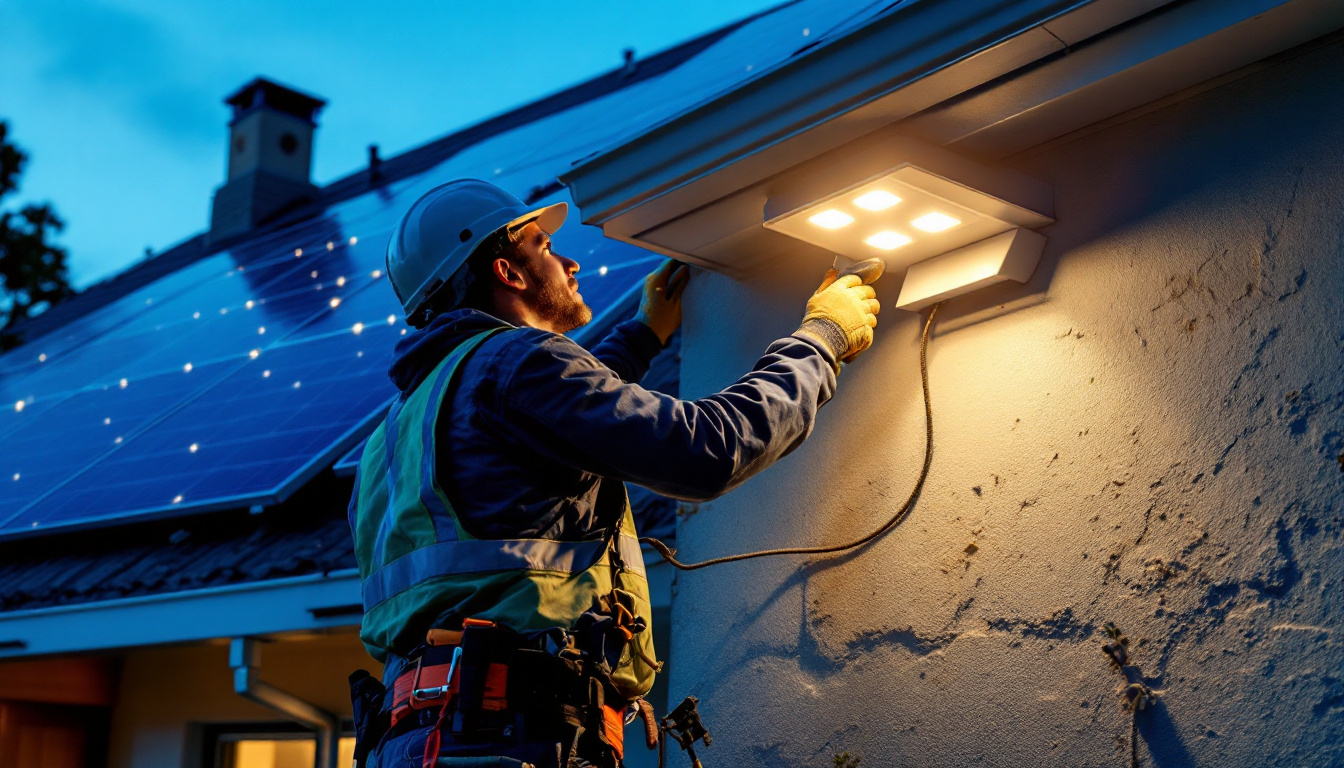
In the fast-paced world of construction and renovation, lighting plays a crucial role in ensuring safety and efficiency. For lighting contractors, mastering the use of work lights, especially string lights, is essential for creating well-lit environments that enhance productivity. This article delves into the top resources available for lighting contractors to master the art of work lights string, providing insights into best practices, tools, and innovative solutions.
Work lights string, often referred to as string lights, are versatile lighting solutions that can be used in various settings, from construction sites to outdoor events. These lights provide broad illumination, making them ideal for tasks that require visibility over large areas. Understanding their components, types, and applications is the first step toward mastering their use.
Work lights string typically consists of several key components: the light bulbs, the wiring, and the connectors. The bulbs can vary in type, including LED, incandescent, or halogen, each offering different levels of brightness and energy efficiency. The wiring is designed to withstand harsh conditions, ensuring durability on job sites. Connectors play a vital role in linking multiple strands together, allowing for customizable lighting setups.
When selecting work lights string, it is essential to consider the wattage and lumens produced by the bulbs. Higher wattage generally translates to brighter light, but it also impacts energy consumption. Therefore, balancing brightness with energy efficiency is crucial for contractors looking to optimize their lighting solutions. Additionally, it’s worth noting that some work lights string come with built-in features such as dimmers or timers, enhancing their functionality and allowing for greater control over the lighting environment, which can be particularly useful in settings that transition from day to night.
There are various types of work lights string, each tailored to specific applications. For instance, heavy-duty string lights are designed for construction sites, featuring rugged materials that resist damage from environmental factors. On the other hand, decorative string lights can enhance the aesthetics of outdoor events while still providing adequate illumination.
Another popular option is the LED work lights string, known for their energy efficiency and long lifespan. These lights produce less heat, making them safer for prolonged use in confined spaces. Understanding the different types available allows contractors to select the most suitable option for their projects. Furthermore, some LED string lights are equipped with smart technology, enabling remote control and scheduling through smartphone applications. This feature not only adds convenience but also allows for energy savings by ensuring lights are only on when needed. In addition, many work lights string are designed to be weather-resistant, making them ideal for outdoor use in varying climates, from rainy conditions to extreme heat, thus broadening their applicability across different projects and environments.
To maximize the effectiveness of work lights string, contractors should adhere to best practices that ensure safety and efficiency. Proper installation, maintenance, and usage are critical components that can significantly impact the overall performance of the lighting setup.
When installing work lights string, it is essential to assess the job site and determine the optimal locations for placement. Lights should be positioned to minimize shadows and provide even illumination across the workspace. Additionally, securing the lights with appropriate fasteners can prevent accidents caused by falling lights.
It is also advisable to use extension cords rated for outdoor use, especially when working in exposed environments. This ensures that the electrical components remain safe from moisture and other elements that could lead to malfunctions or hazards. Furthermore, utilizing GFCI (Ground Fault Circuit Interrupter) outlets can add an extra layer of safety, particularly in wet conditions, by automatically cutting off the power supply in case of a fault.
Maintaining work lights string is vital for ensuring longevity and consistent performance. Regularly inspecting the lights for any signs of wear or damage, such as frayed wires or broken bulbs, can prevent potential issues before they escalate. Cleaning the lights periodically to remove dust and debris can also enhance their brightness and efficiency.
Contractors should establish a maintenance schedule that aligns with the frequency of use. Keeping a log of inspections and replacements can help track the condition of the lights and ensure that they are always in optimal working order. Additionally, it’s beneficial to have a supply of replacement bulbs and fuses readily available on-site. This proactive approach not only minimizes downtime but also reinforces a culture of safety and readiness among the crew, ensuring that everyone is prepared to tackle the tasks at hand without unnecessary delays.
As technology continues to advance, innovative solutions are emerging that can enhance the effectiveness of work lights string. Lighting contractors should stay informed about these developments to remain competitive in the industry.
Smart lighting technology is revolutionizing the way work lights are utilized. With features such as remote control, dimming capabilities, and programmable settings, contractors can tailor their lighting solutions to meet specific project requirements. This not only improves efficiency but also contributes to energy savings.
Integrating smart technology into work lights string can also enhance safety. For example, motion sensors can automatically turn lights on or off based on activity in the area, reducing energy waste and ensuring that lights are only used when needed. Furthermore, many smart lighting systems can be integrated with mobile apps, allowing contractors to monitor and adjust lighting remotely. This level of control can be particularly beneficial during large-scale projects, where lighting needs may change frequently throughout the day.
Another innovative solution gaining popularity is solar-powered work lights string. These lights harness solar energy, making them an eco-friendly option for outdoor projects. They are particularly useful in remote locations where access to electricity may be limited.
Solar-powered string lights are equipped with rechargeable batteries that store energy during the day and provide illumination at night. This technology not only reduces energy costs but also minimizes the carbon footprint of construction projects. Additionally, advancements in solar panel efficiency mean that these lights can now generate more power in less sunlight, making them even more versatile. Many models come with adjustable solar panels that can be positioned to capture the maximum amount of sunlight, ensuring reliable performance even in less-than-ideal weather conditions. This adaptability makes solar-powered work lights an excellent choice for contractors looking to embrace sustainable practices while maintaining high standards of functionality.
To further enhance their mastery of work lights string, lighting contractors can leverage various resources available in the industry. From online platforms to professional organizations, these resources provide valuable information and networking opportunities.
Numerous online learning platforms offer courses and tutorials specifically designed for lighting contractors. These platforms cover a wide range of topics, including installation techniques, safety protocols, and the latest lighting technologies. Engaging with these resources can help contractors stay updated on industry trends and best practices.
Additionally, many of these platforms provide certification programs that can enhance a contractor’s credentials, making them more competitive in the job market. Investing time in continuous education is crucial for professional growth in the ever-evolving field of lighting.
Joining industry associations can provide networking opportunities and access to exclusive resources. Organizations dedicated to lighting and electrical contracting often host events, workshops, and conferences where contractors can learn from experts and share experiences with peers.
Online forums and discussion groups are also valuable resources for contractors seeking advice or solutions to specific challenges. Engaging with a community of professionals can foster collaboration and knowledge sharing, ultimately leading to improved practices and innovations in lighting.
Safety is paramount in any construction environment, and work lights string is no exception. Understanding the potential hazards and implementing safety measures is essential for protecting workers and ensuring compliance with regulations.
When working with electrical components, contractors must prioritize electrical safety. This includes using lights that are rated for the intended application and ensuring that all connections are secure. Ground fault circuit interrupters (GFCIs) should be used in outdoor settings to prevent electrical shock in wet conditions.
It is also important to educate workers about the proper use of work lights string. Providing training on how to handle and install lights safely can reduce the risk of accidents and injuries on the job site.
Contractors should be mindful of the environmental impact of their lighting choices. Opting for energy-efficient options, such as LED lights or solar-powered string lights, can significantly reduce energy consumption and lower carbon emissions. Proper disposal of old or damaged lights is also crucial to minimize waste and adhere to environmental regulations.
Mastering work lights string is essential for lighting contractors aiming to create safe and efficient work environments. By understanding the components, types, and best practices associated with these lighting solutions, contractors can enhance their skills and improve project outcomes. Additionally, staying informed about innovative technologies and leveraging available resources can further elevate their expertise in the field.
As the industry continues to evolve, embracing new solutions and prioritizing safety will be critical for success. By investing in education and adopting best practices, lighting contractors can illuminate their paths to mastery and ensure a brighter future for their projects.
Ready to elevate your lighting game with the best in spec-grade lighting products? Look no further than LumenWholesale, where we provide contractors with superior lighting solutions at unbeatable wholesale prices. Say goodbye to inflated markups and hello to a vast selection of reliable, high-performance lighting that meets the highest industry standards. With the convenience of free shipping on bulk orders, you can ensure your projects shine brightly without breaking the bank. Wholesale Lighting at the Best Value is just a click away—experience the LumenWholesale difference today!

Discover the essential steps to installing a fluorescent tube light bulb with ease.

Discover the innovative strategies lighting contractors are using to integrate LED and solar technologies.

Discover how solar lanterns can transform your lighting projects with eco-friendly efficiency and style.

Discover the crucial role of warehouse lighting design in enhancing safety, efficiency, and productivity.